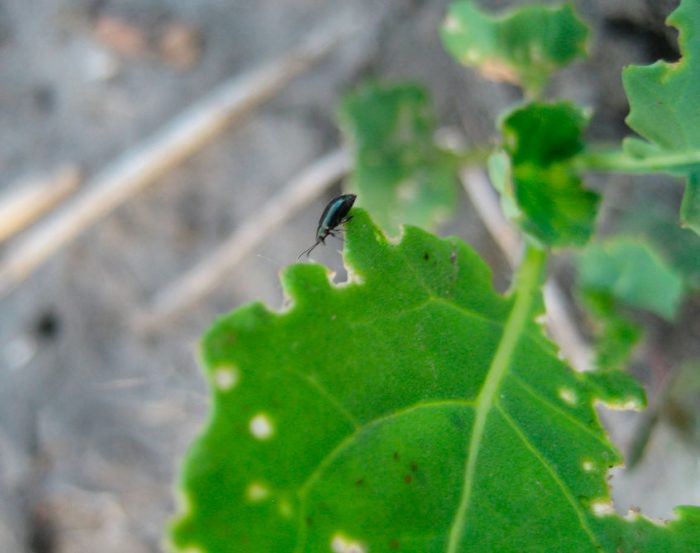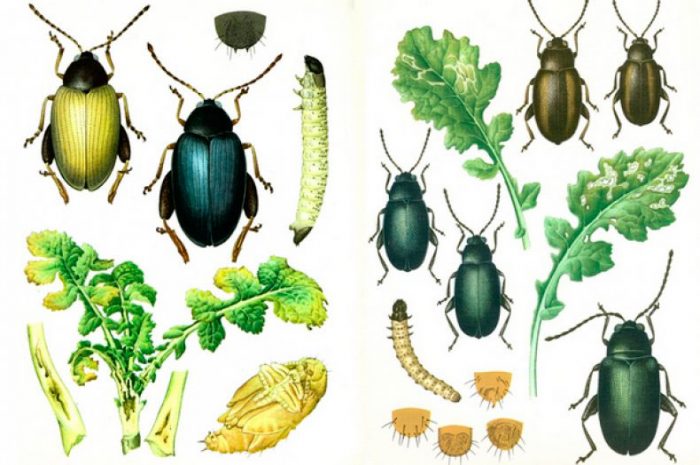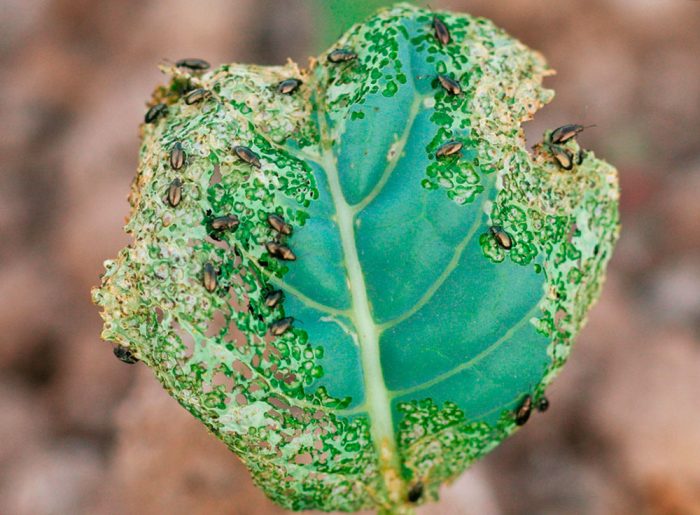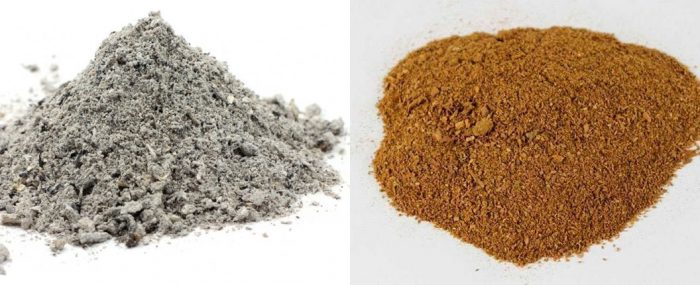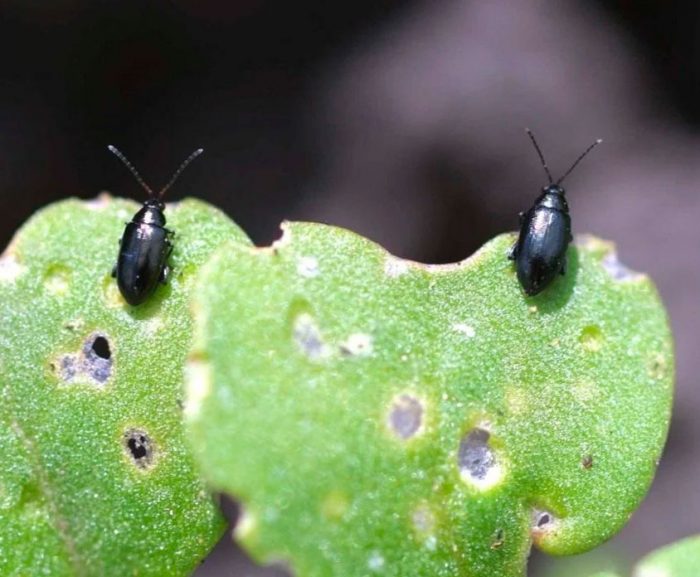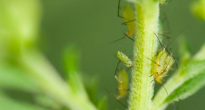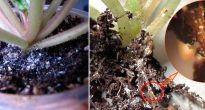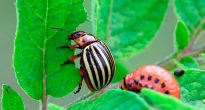The cruciferous flea (Phyllotreta crusiferae), or the cabbage flea, is an insect that belongs to the species of earthen fleas of the Kozyavok subfamily of the leaf beetle family. In nature, such an insect can be found in the Caucasus, Turkey, Europe, Central Asia, and also in the Mediterranean region. Both adults and larvae eat the foliage of representatives of the Cruciferous (Cabbage) family, namely: radish, horseradish, turnip, all types of cabbage, rape, radish, daikon and turnip.
Content
Features of the cruciferous flea
The cruciferous flea is a harmful insect and is a flying beetle that can reach 0.15–0.3 cm in length. The body is oval-oblong. There are also antennae, which in length reach no more than 1/3 of the body length. The hind legs of the bug are leaping.
Types of cabbage flea beetles differ in the color of the elytra, which can be striped, black or with a metallic sheen. The larvae of such an insect eat thin roots of plants. The greatest harm to garden crops is caused by such types of cruciferous fleas as: blue, notched, wavy, light-legged and black flea.
How to deal with a flea in the garden
Fleas on cabbage
The cruciferous flea can settle on cabbage after the outside air warms up to 15 degrees. In order not to freeze in winter, the pest hides under plant debris or in the upper soil layer. The insect damages all cabbage plants in the same way, it can look like skeletonization, ulcerative gnawing, or as interveinal gnaws. Those leaf plates that are very badly damaged begin to dry and then die off, over time the plant itself begins to die.
Can a cruciferous flea be harmful at an early stage of cabbage development? Insects injure the surface of foliage and shoots, which causes ulcers to appear, which then become holes. Because of this, yellowing of the foliage begins. Injured seedlings can die in just a few days, especially if the weather is very warm. As soon as the bugs are found, you need to immediately begin an active fight with them.
How to save cabbage? The cabbage, which belongs to the early ripening varieties, is recommended to be processed exclusively with folk remedies, since they do not contain substances hazardous to humans.So, once a week, the bushes should be sprayed with infusion of tobacco or wood ash, a solution of vinegar or a decoction of tomato tops. And you can spray late and mid-season cabbage varieties with special chemicals, for example: Aktellik, Karate, Aktara, Decis or Bankol.
Bugs that have settled on radishes, on radishes or on other representatives of the Cruciferous family can also harm them very much. The fact is that if the foliage is injured, then the root crop will lose nutrition. The fight should begin immediately after the first pests are found. In order to get rid of them completely, you will need to spend several sprays.
Fleas on other crops
The cabbage flea can harm both cruciferous and other crops. It can also injure levkoi, roses and chrysanthemums. How to save flowers from a cruciferous flea? For pest control, you can use the same drugs as for cruciferous crops. However, in this case, insecticidal preparations can be used without fear.
Any crops from fleas are treated in the evening, when the sun goes down, at which time the pests are on the surface of the foliage.
Effective chemicals
In the fight against the cabbage flea, the following insecticidal preparations are most popular among summer residents:
- Aktara... It is a systemic insecticidal preparation of contact-intestinal action, which can cope with a large number of various harmful insects, including those that live and suck.
- Actellic... Organophosphate non-systemic insectoacaricidal preparation of contact-intestinal action, which is used in the fight against leaf-gnawing and sucking harmful insects.
- Karate... Contact-systemic combined insecticidal agent with which they fight sucking and gnawing pests.
- Bankcol... It is an insecticidal preparation of contact-intestinal action that destroys sucking and gnawing harmful insects.
- Decis... A broad-spectrum contact-intestinal insecticidal agent from the pyrethroid group. It effectively fights lepidoptera, coleoptera and homoptera harmful insects.
In addition to these drugs, you can use Inta-Vir, Mospilan, Fitoverm and others of similar action.
Folk remedies
Vegetable crops affected by cruciferous flea beetles are recommended to be sprayed with chemicals only as a last resort, because they contain poisons that are dangerous to both humans and beneficial insects. Instead of chemistry, experienced gardeners advise using folk remedies that are not only safe, but also quite effective.
Most often, summer residents use the following effective folk remedies in the fight against a pest:
- Seedlings immediately after transplanting into open ground must be powdered with wood ash; you can also use tobacco dust combined with ash (1: 1) for this. Pollination is carried out on a fine, windless day, while there should be no rain in the near future after treatment. This procedure is carried out three times with a break of 4 or 5 days. After pollination on all leaves, both surfaces should be covered with the composition.
- Vegetables need to be sprayed with a decoction made from tomato tops: combine 2 kg of dry or 4 kg of fresh tops with a bucket of cold water, wait four hours and boil the mixture over low heat for 30 minutes. The cooled and strained broth is combined with water in a 1: 1 ratio and with grated or liquid soap, taken in an amount of 40 grams. The composition of the bushes is treated three times with a break of three or four days.
- Pass through a meat grinder 1 tbsp. garlic and the same amount of tomato tops. The resulting mass is poured with a bucket of lukewarm water. Mix everything well and strain.One large spoonful of liquid soap is poured into the resulting product, after which the bushes are sprayed with the resulting product.
- 500 g of dandelion roots and foliage are combined with a bucket of water, do not forget to grind them first. Stir well and strain. Pour some liquid soap into it before processing.
- A bucket of water is combined with a pair of glasses of wood ash. The mixture should be infused for two days, after which it is carefully drained and ¼ part of a bar of tar soap is dissolved in the resulting product, which is previously ground on a grater.
- 10 liters of hot water is combined with 0.2 kg of tobacco dust. The cooled and strained infusion is combined with one large spoonful of dishwashing liquid or liquid soap.
- 10 liters of water are combined with 2 large spoons of vinegar essence or 1 tbsp. vinegar (9%). Spray the foliage with a well-mixed solution.
- A couple of liters of water are combined with 1 kg of finely chopped wormwood. The mixture is boiled over low heat for 10-15 minutes. The cooled broth is mixed with 100 grams of chopped garlic and filtered. The volume of the resulting product is brought up to 10 liters with clean water.
- 5 liters of water are combined with 2 kilograms of potato tops and boiled over low heat for half an hour. The cooled broth is filtered and diluted in half with water. Processing is carried out in the evening.
- Prepare an infusion of chicken manure in a ratio of 1:20. It is kept in the open air for seven days, after which it is filtered and you can start processing. This infusion will not only scare off flea beetles, but also become a source of nitrogen for plants.
- Combine half a bucket of water with one tablespoon of flea repellent (available at the pet store). The resulting solution is sprayed with bushes.
- A flag is made of cardboard or thin plywood, both surfaces of which are covered with solid oil or resin. Walk several times along the rows with plants on which fleas have settled, do not forget to wave the flag and touch the foliage with it. Frightened pests will start jumping, and most of them will stick to the flag.
- Take a few pieces of cloth and soak them in used car oil or diesel oil. Distribute them on sheets of cardboard in the aisles of the beds, while the distance between them should be about four meters. After two or three days, you need to turn the fabric over to the other side, so that much more pests will be collected.
How to carry out preventive treatments
Experts advise that it is better to prevent the appearance of a cabbage flea on the site than to try to get rid of it. Preventive measures:
- After the seedlings are transplanted into open ground, they are covered with a non-woven material. After the seedlings get stronger, their foliage will become coarser and it will no longer attract fleas. At this time, it will already be possible to remove the shelter.
- The smell of coriander, dill and garlic repels this pest, so it is recommended to grow cabbage next to them. When growing late varieties of cruciferous crops, you can protect them from such a harmful insect using mixed plantings with nasturtium, marigolds or calendula.
- Every day, freshly picked wormwood should be put in the aisles on the beds.
- In water intended for irrigation, you need to pour 10-15 drops per bucket of such aromatic agents as: valerian tincture, corvalol, pine or fir oil.
Also, some agrotechnical rules will help prevent the appearance of a cruciferous flea on the site:
- Systematically pull up weeds, as the cruciferous flea likes to settle on it.
- In the autumn, when the crop is harvested, they dig the soil in the garden.
- Water and feed the plants on time, thanks to this they will get stronger faster, grow up and become less attractive to the pest.
- It is recommended to plant crops as early as possible, while this harmful insect has not yet woken up.Also, planting seedlings can be carried out in the last days of June, when the flea will not be too scary for her.

